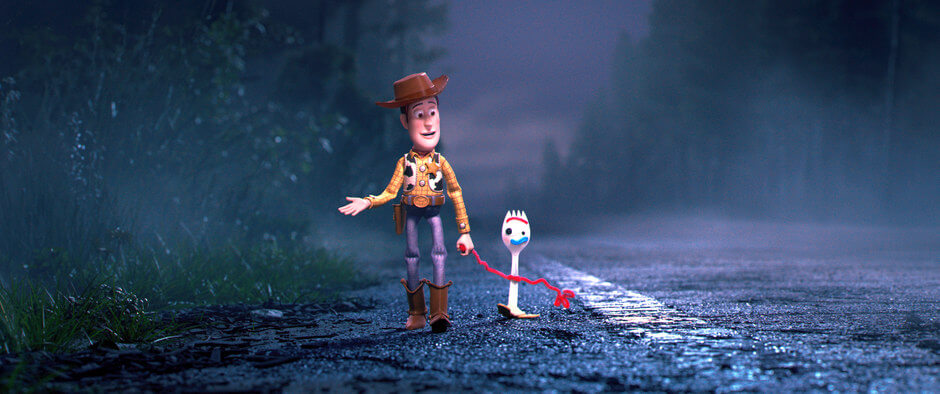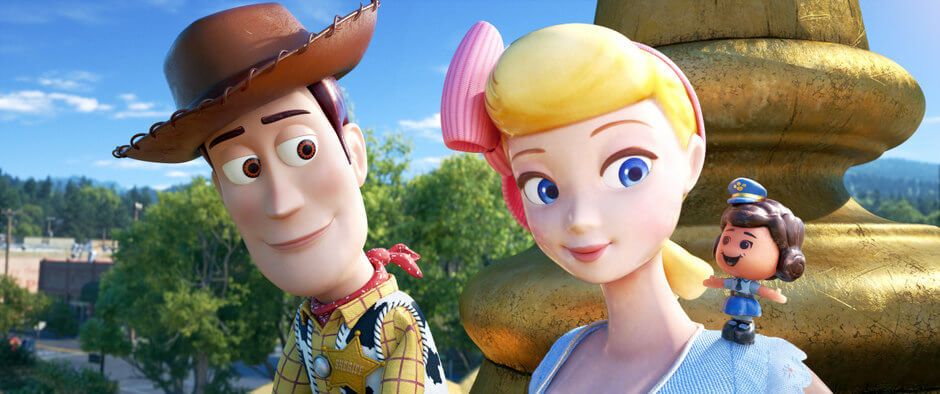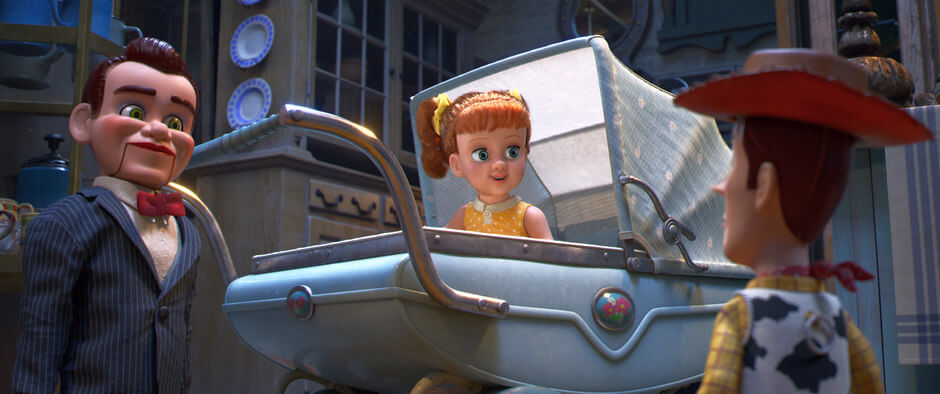Pixar Returns to its Greatest Franchise Success with ‘Toy Story 4’
https://www.awn.com/animationworld/pixar-returns-its-greatest-franchise-success-toy-story-4
“No pressure. No pressure at all.” With a laugh, director Josh Cooley describes how he and his producers, Jonas Rivera and Mark Nielsen, managed to bear the weight of creating Disney · Pixar’s new animated feature film, Toy Story 4, the latest installment in the studio’s most venerable and successful franchise. Hitting theatres this com ing June 21, Toy Story 4 marks Cooley’s feature directorial debut, having previously written and directed the studio’s animated short, Riley’s First Date? As a writer and story supervisor on Inside Out – also produced by Rivera – as well as a storyboard artist on Up and other Pixar projects, Cooley has “coolly” taken the helm of arguably the studio’s most beloved set of CG playthings, first introduced to audiences in 1995.
With one overriding mandate… “don’t mess it up!” No pressure indeed.
With regards to his producers, Cooley states, “We worked together on Inside Out, and Up before that. So, it’s interesting, because those were new and no one had any expectations. People loved those films and we’re proud of them, but it’s such an interesting contrast to be on Toy Story 4 where everyone, even the TSA guy at the airport, was like, ‘Don’t mess it up!’”
“And they say it… they’re not afraid to say it,” adds Rivera, a Pixar veteran who as producer, shared the 2015 Best Animated Feature Film Oscar with director Pete Docter for Inside Out. “Families… everyone! But that’s kind of cool at the same time, because people are invested and love Toy Story films. They want more, they just don’t want you to mess it up.”
And so the pressure is on. “We know that the world cares about these characters because we hear it constantly,” Cooley notes. “And we do too. More than probably anybody, we love the world of Toy Story and everyone in it. So… I can safely say nobody put more pressure on me than me.”
 With Toy Story 4, Pixar once again returns to Woody’s world, a world that made Pixar a household name and spawned a new generation of computer animators cranking out a succession of more and more sophisticated CG animated films that today count among the most financially successful movies of all-time. Toy Story’s incredible success established Pixar as the most important and successful CG animation studio in the world. Toy Story was directed by John Lasseter from a story he wrote with Pete Docter, Joe Ranft and Andrew Stanton, four animation legends responsible individually and collectively for practically every studio success of the next 20+ years. Toy Story was the studio’s first feature film as well as the first fully computer animated feature film ever made. It’s almost inconceivable today to consider that just prior to the film’s release, many Pixar employees were polishing up their resumes, assuming they’d be looking for work once the film was released… and bombed at the box office.
With Toy Story 4, Pixar once again returns to Woody’s world, a world that made Pixar a household name and spawned a new generation of computer animators cranking out a succession of more and more sophisticated CG animated films that today count among the most financially successful movies of all-time. Toy Story’s incredible success established Pixar as the most important and successful CG animation studio in the world. Toy Story was directed by John Lasseter from a story he wrote with Pete Docter, Joe Ranft and Andrew Stanton, four animation legends responsible individually and collectively for practically every studio success of the next 20+ years. Toy Story was the studio’s first feature film as well as the first fully computer animated feature film ever made. It’s almost inconceivable today to consider that just prior to the film’s release, many Pixar employees were polishing up their resumes, assuming they’d be looking for work once the film was released… and bombed at the box office.
“Toy Story is the birthplace of Pixar,” Rivera explains. “It’s immensely important to this place. I always think of Woody and Buzz, as the Mickey and Donald of Pixar. So, that was part of the pressure as well, taking on these really important characters. They have incredible meaning, not just to audiences but to everyone at the studio. Moving forward, I feel a little bit like we’re their guardians. This is the end of the Toy Story movies, for the sake of argument, as we’ve always said that each one was kind of the end. But, there’s something really powerful in them… that goes beyond the movies themselves. I grew up loving old Disney movies and animation. To have kids now playing with toys of the things I’ve had a hand in creating, right alongside toys of the things I watched when I was a kid, you can’t help but feel a little overwhelmed when you think about the impact and importance of these positive, sweet characters to the company and to audiences. It’s so much bigger than we are.”
Toy Story 4 marks the cinematic return of Woody (Tom Hanks) and Buzz Lightyear (Tim Allen), two of the most popular and enchanting characters in all of animation, who along with Jessie (Joan Cusack), Mr. and Mrs. Potato Head (Don Rickles and Estelle Harris), Slinky Dog (Blake Clark), Hamm (John Ratzenberger) and Rex (Wallace Shawn), share a new adventure with their kid, Bonnie, a family road trip that sees them reunite with Bo Peep (Annie Potts) as well as meet a new set of toys, led by Forky (played by Tony Hale), Duke Caboom (played by Keanu Reeves) and a pair of carnival prizes, Ducky and Bunny (played by Keegan-Michael Key and Jordan Peele).
Hundreds, perhaps thousands of articles have been written over the years detailing Pixar’s relentless pursuit of CG animation virtuosity, their continual development of ever more sophisticated and visually stunning animation production techniques and technologies. But, the recent onslaught of technically proficient but less than compelling CG animated features has shown that Pixar’s creative brilliance is not exemplified merely by how they light or composite shots, or by the fluidity and complexity of their hair and water simulations. History bears witness to the fact that time and time again, Pixar has delivered characters and stories with heart and humor, memorably emotional performances that resonate with audiences in ways few other studios have captured and mastered as consistently or successfully. The Toy Story franchise, by most accounts, has produced the studio’s most consequential characters.
For Cooley and his team, Toy Story 4 began with an important question: Why Toy Story 4? Hadn’t the Oscar-winning Toy Story 3 brought the revered film franchise to its logical conclusion? “The question for us was like, ‘Why make another one,’” Cooley acknowledges. “We had to come up with something that was worthy, that had the same emotion, adventure and humor that could stand right up there with the first three films. That was the thing up on the wall — this needs to earn the title of Toy Story 4. That’s what we were aiming for.”
The answer to that burning question came from their exploration of how the next chapter of Woody’s life might play out. According to Rivera, they began by addressing a central story development question: “What’s next for Woody?” “It’s all about Woody,” the producer notes. “Every single Toy Story film has been that way. So, this film should be no different. We realized that the first three films were about his time with Andy and that story came to a conclusion. But, we found there’s more of Woody’s story to tell. The Woody storyline became the most important thing. We had to make sure that everybody else supported his story as well. Buzz and Jessie, Bo as well as the new characters… how can they support him? So, once we keyed into that, we could determine how this character can do this, how Gabby can do this, how Duke can do this, all to support Woody. That made it feel like they all belonged together.”
 Nielsen agrees. “It had to be Woody’s story. So, how do we continue the story of this character, who is kind of perfect and has everything given to him, yet is so loving and caring? How do you keep that going? It was hard to stay true to where we’ve been with him and also push him even further.”
Nielsen agrees. “It had to be Woody’s story. So, how do we continue the story of this character, who is kind of perfect and has everything given to him, yet is so loving and caring? How do you keep that going? It was hard to stay true to where we’ve been with him and also push him even further.”
The daunting challenge then became how to find a story to tell about Woody, now with a new kid, Bonnie, that would feel familiar without seeming like a stale retread of ideas already explored in previous films. “We knew how much the story had to mean, that it had to be emotionally relevant, that is had to be surprising and not deal with too much sameness,” Cooley says. “We got that. But the challenge became, how do you set that up? How do you use and balance all these characters? How do you make that a motion picture? We sat around for a long time saying, ‘That’s a great idea!’ Then we would write it, draw it, cut it, look at it… and then say, ‘Yeah… but it’s not the right movie yet.’”
“The hardest part of the storytelling was honoring and dramatizing that idea in a way that didn’t feel clumsy or too long or too funny or too sad,” Rivera adds. “You know, it must have taken us seven or eight story versions to course correct into something that played and felt like a movie.”
“What we often do is get up in front of the crew, or the company, and show the story reels,” Nielsen notes. “We’ll introduce it and set it up, where we kind of paint a picture for the audience a little bit, give the caveats. But, we can’t do that at the AMC!” Cooley laughs in agreement. “This has to be airtight. It has to stand alone. It’s an exhausting, trial and error process. A long process. Lots of screenings. You go down so many roads where you say to yourself, ‘You know what, that’s not the road we needed to go down. Let’s try something new.’ It takes time to make the story airtight. But, we knew we had to give the story the time it needed. It had to be great.”
 Now with only six weeks to go until the Woody and company’s latest escapades hits theatre screens, the director’s heartfelt sentiment sets the stage for what we all hope, dare say fully expect, is another touching and hilarious chapter in the lives of a sometimes fussy, sometimes silly but always charming group of kid’s toys, being brought to life by the very first studio to ever capture the hearts of audiences through the wonder of CG animation almost 25 years ago. “We’re super proud of the way this movie is ending up,” Cooley says. Pointing to his two producers, the director concludes, “It’s really rewarding for us right now to see how it’s all come together. We’re seeing all this hard work pay off. It’s so hard to make these movies. But, after taking four and a half tough years, cramming them into 88 minutes and then seeing people smile… it’s pretty emotional. It’s pretty cool. We’re fortunate to be able to stand on the shoulders of the three phenomenal Toy Story movies that came before this to build on them and add to that legacy. More than anything, for us, it was a privilege.”
Now with only six weeks to go until the Woody and company’s latest escapades hits theatre screens, the director’s heartfelt sentiment sets the stage for what we all hope, dare say fully expect, is another touching and hilarious chapter in the lives of a sometimes fussy, sometimes silly but always charming group of kid’s toys, being brought to life by the very first studio to ever capture the hearts of audiences through the wonder of CG animation almost 25 years ago. “We’re super proud of the way this movie is ending up,” Cooley says. Pointing to his two producers, the director concludes, “It’s really rewarding for us right now to see how it’s all come together. We’re seeing all this hard work pay off. It’s so hard to make these movies. But, after taking four and a half tough years, cramming them into 88 minutes and then seeing people smile… it’s pretty emotional. It’s pretty cool. We’re fortunate to be able to stand on the shoulders of the three phenomenal Toy Story movies that came before this to build on them and add to that legacy. More than anything, for us, it was a privilege.”

熱門頭條新聞
- Will AI revolutionize 2D animation ?
- Japan’s low-paying anime industry wrestles with exodus of animators
- Gamescom 2025 – Submissions Are Open Until April 9th
- Salary transparency: InnoGames salaries remain stable at a high level
- Electrician Simulator VR – Immersive Electrical Repairs Like Never Before!
- Montréal International Game Summit
- Games as a Brand Marketing Channel
- Abidjan Animation Film Festival 2025
